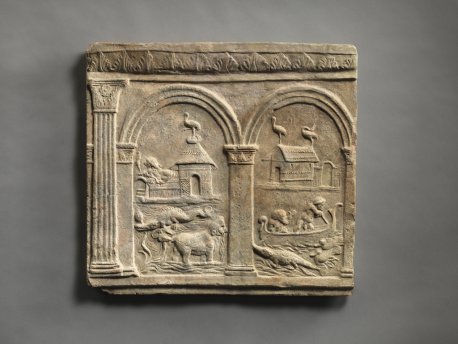"Campana" Relief with Roman Nilotic Landscape
Overview
"Campana" Relief with Roman Nilotic Landscape [ edit ]
Starting in the late Republican period and increasing after the conquest of Egypt, many Romans decorated their houses with “Nilotic scenes”: frescoes, mosaics, or, as in this case, terracotta reliefs depicting the Nile in flood. Nilotic scenes, often thought to present exoticizing or unflattering caricatures of life in Egypt, are actually subtle and complex evocations of the annual Nile flood and the religious celebrations appropriate to that time of year. The appearance of these themes in private houses may thus testify to some Roman awareness of, and interest in, the festivals in question.
This particular Nilotic scene belongs to the category of “Campana reliefs”: mold-made terracotta reliefs that lined the interior and exterior walls of houses and temples. Such reliefs were particularly popular in the Middle Italian region from about 50 BCE to 150 CE; their decoration includes various iconographic genres, sometimes including Nilotic scenes. This example comes from a series of which several other examples exist.
Many specific features of this relief allude to the inundating Nile. As in other Nilotic Campana reliefs, the columns and archways suggest that the viewer looks out from an interior space onto the landscape, in which the foreign flora and fauna immediately signal the specific setting of Egypt. The crocodile and the hippopotamus in the relief, like the crocodile and the mongoose in Personification of the Nile, visually label the landscape.
Both works of art also share another common feature of Nilotic landscapes: pygmies, who came from the far south of Egypt. Beneath the right-hand arch, two pygmy-figures pilot a reed boat. The diminutive figures provide an element of humor, but are also a serious allusion to the ancient Egyptian theology of the inundation. The rising waters of the Nile marked the coming of the “wandering goddess,” who can be specified as Hathor, Isis, or any number of local goddesses, who returned from her winter sojourn in the far south and brought with her fantastic creatures and humans from this region.
On the riverbank is a semi-nude female, viewed from behind; she reclines on a kline and lifts a drinking vessel, alluding to the frequent depictions of alcohol consumption and sexual activity in other Nilotic scenes. To the left of the woman, above an archway and small staircase, stands an ithyphallic statue of Priapus. These iconographic allusions to sexuality and drinking evoke, among other things, Egyptian celebrations for the wandering goddess, who reunited with her spouse upon her return to Egypt, and whose festivals often featured inebriation. Next to the reclining figure, the peaked reed structures – on which three storks sit – may evoke not only the huts of the southern pygmies but also the temporary festival structures, seemingly of organic material, that accompanied Inundation-related ritual drinking on the banks of the Nile.
Period
1st Century CE
Dimensions
H. 48.3 cm; W. 51.3 cm; Th. 4.1 cm
Provenance
Italy
Museum
Princeton University Art Museum
Accession Number
y1962-143
Credit Line
Gift of Edward Sampson, Class of 1914, for the Alden Simpson Collection
C. Barrett, Egyptianizing Figurines from Delos. Columbia Studies in the Classical Tradition 36. (Leiden 2011).
A.H. Borbein, Campanareliefs: typologische und stilkritische Undersuchungen (Heidelberg: F.H. Kerle Verlag, 1968)
J.C. Darnell, “Hathor Returns to Medamûd,” Studien zur Altägyptischen Kultur 22 (1995), 47-94.
P.G.P. Meyboom, The Nile Mosaic of Palestrina: Early Evidence of Egyptian Religion in Italy (Leiden/Boston: Brill, 1995).
Rita Perry, Die Campanareliefs (Mainz: Philipp von Zabern, 1997)
Marion Rauch, Bacchische Themen und Nilbilder auf Campanareliefs (Rahden/Westf.: Verlag Marie Leidorf GmbH, 1999).
M. J. Versluys, Aegyptiaca Romana: Nilotic Scenes and the Roman Views of Egypt (Leiden/Boston: Brill, 2002).













